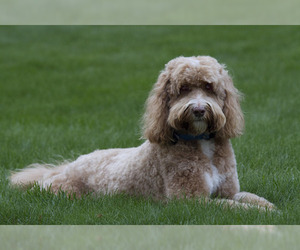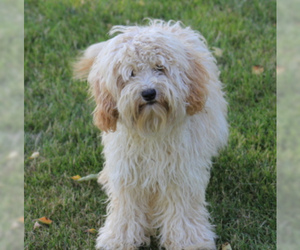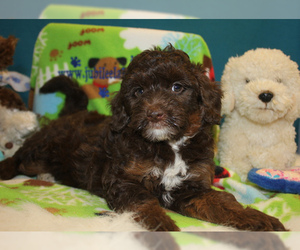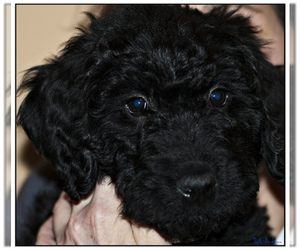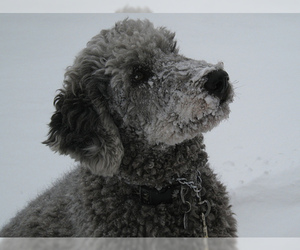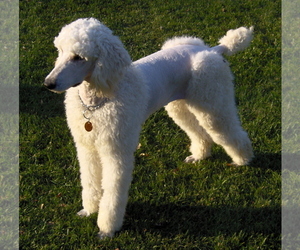All about Labradoodle dog breed
A.K.A. :Cobberdog
Labradoodle is a mix of
Size
Grooming requirements
Exercise requirements
Good with other dogs
Watchdog ability
Energetic
Training requirements
Playful
Affectionate
Good with other pets
Good with children
Good with strangers
Winter
Summer
Healthiness
Protective
Life Span
| Mixed Breeds | Member |
| Breeds A - Z | L |
| Breeds by Group | Non-Sporting |
| Breeds by Trait | Good With Kids Hypoallergenic Low Shedding Smartest Dog Breeds |
| Overview: | The Labradoodle is a charming and increasingly popular hybrid breed, originating in Australia in the late 1980s with the goal of creating a guide dog for a visually impaired individual allergic to dog hair. This delightful canine combines the best traits of its parent breeds: the intelligent Poodle (Standard) and the friendly Labrador Retriever. Physically, Labradoodles boast a range of sizes and coat types, from wavy fleece to curly wool, often shed-reduced, making them a potential option for individuals with mild allergies. Their coats come in various colors, including cream, chocolate, and black. Temperamentally, they are known for being sociable, intelligent, and trainable, making them excellent family pets. They thrive on human companionship and require moderate exercise to stay happy and healthy. While adaptable, their energy levels mean they generally prefer homes with yards over small apartments, though daily walks are essential. Common health considerations, inherited from their parent breeds, can include hip and elbow dysplasia, eye conditions, and certain cancers, so choosing a reputable breeder is crucial for a healthy companion. |
F.A.Q.
All You Need to Know About the "Labradoodle" Breed (parent breeds: "Labrador Retriever" × "Poodle (Standard)")
The delightful Labradoodle, a cross between a Labrador Retriever and a Standard Poodle, originated in Australia in the late 1980s as a hypoallergenic guide dog. These intelligent and friendly dogs are known for their generally outgoing and affectionate temperament, making them fantastic family pets. Physically, they boast a range of coats—from wavy to curly—in various colors, with many shedding minimally, appealing to those with allergies. While they can adapt to apartment living with sufficient daily exercise, a home with a yard is ideal. Their beautiful coats require regular grooming to prevent matting, typically every 6-8 weeks, plus daily brushing. Labradoodles are highly trainable and eager to please, thriving on interaction and positive reinforcement. Potential health concerns include hip and elbow dysplasia, progressive retinal atrophy, and certain heart conditions, so choosing a reputable breeder is crucial for a healthy, happy companion.The Labradoodle weight typically ranges from 50 to 80 pounds for adults, with average size being around 60-70 pounds. Males generally trend towards the higher end of this scale, while females are usually slightly lighter. Maintaining a healthy weight for Labradoodle is crucial for their well-being.
How tall is a Labradoodle? Understanding Labradoodle HeightThe average Labradoodle height typically falls between 21 and 24 inches at the shoulder for an adult dog. This measurement is taken from the ground to the top of the shoulder blades (withers).When considering how tall is a Labradoodle, it's helpful to look at the typical adult height range. Most adult Labradoodles will stand between 21 to 24 inches tall. However, there can be some variation based on several factors:* Gender: Male Labradoodles tend to be slightly taller and heavier than females, though this difference isn't always significant.* Parentage: The size of the parent dogs (the Labrador Retriever and the Standard Poodle) plays a crucial role. A Labradoodle from larger parents is more likely to be on the higher end of the height spectrum.* Individual Genetics: Just like with humans, there's always some genetic variability. Even within the same litter, you might see slight differences in adult size.While 21-24 inches is the most common range for a Labradoodle’s average size, some individuals may be a bit shorter or taller. We recommend discussing the expected adult size with your breeder, as they often have a good understanding of their specific lines. This information is key for potential adopters or buyers comparing breed dimensions for their living situation.
Labradoodle Colors: A Comprehensive Guide to Coat TypesLabradoodles boast a stunning array of coat colors, influenced by their diverse parent breeds, the Labrador Retriever and the Poodle. When considering a Labradoodle, understanding the various Labradoodle colors is crucial for potential owners.You'll find Labradoodle colors in a wide spectrum, including common and officially recognized shades, as well as more rare and exotic Labradoodle variations.Common Labradoodle Colors (often referred to as "recognized" or "standard" by various breed clubs, though not by major kennel clubs like the AKC, as Labradoodles are not AKC-recognized):Expect to see Labradoodles in beautiful shades such as Black, a solid and sleek classic. Chocolate (ranging from light milk chocolate to dark bittersweet) is also very popular. Cream and Apricot are warm, light tones, with apricot having more orange undertones. Red Labradoodles are a vibrant and striking color. Gold (often mistaken for cream or apricot but with a distinct richer hue) is another beautiful option. Silver and Blue (a dilute black, appearing as a dark grey-blue) are also seen, often developing over time. White Labradoodles are also available, often with black pigmentation.Rare and Exotic Labradoodle Variations (not officially recognized by any major kennel club for Labradoodles):For those seeking truly unique Labradoodle coat types, several rare and exotic Labradoodle variations exist. Parti-color Labradoodles feature a solid color with distinct white patches. Phantom Labradoodles display two distinct colors, with specific markings on the face, chest, legs, and under the tail, similar to a Doberman's markings. Brindle coats have stripes of different colors, often appearing as a tiger-stripe pattern. Merle Labradoodles, characterized by mottled patches of color, are sometimes seen but are considered controversial due to potential health implications when bred improperly. Lilac (a dilute chocolate, appearing as a greyish-purple) is another extremely rare and sought-after color. These rare Labradoodle colors can often command higher prices due to their unique appearance and scarcity.It's important to note that since the Labradoodle is a hybrid breed, AKC recognized Labradoodle colors do not exist, as the AKC does not recognize the Labradoodle breed itself. However, many Labradoodle breed associations and clubs have their own standards and preferred colors. When choosing a Labradoodle, consider the coat type (fleece, wool, or hair) in addition to the color, as this will impact grooming needs. Always inquire about the parent dogs' lineage and genetic health clearances, especially when considering rare coat types.
The Labradoodle personality is generally delightful, blending the best traits of its parent breeds. These dogs are typically very friendly, known for their outgoing and amiable nature, making them excellent companions. They exhibit strong loyalty to their families, often forming deep bonds with their human companions. Their high sociability means they generally get along well with people and other animals. Regarding children, Labradoodles are usually very good-natured and patient, making them wonderful family pets. They also tend to be quite amiable with other pets, especially when properly socialized from a young age.While adaptable, they are not ideally suited for prolonged apartment living without significant daily exercise and mental stimulation. Labradoodles are energetic dogs that thrive in environments where they have space to move and play. They require regular activity to prevent boredom and maintain their cheerful disposition. Their temperament of Labradoodle is often described as intelligent, eager to please, and playful.
The Labradoodle temperament is a delightful blend of its parent breeds, making for an exceptional companion dog behavior. Known for being friendly, sociable, and highly loyal, they thrive on human interaction and are generally eager to please. Their warm nature makes them excellent family pets, typically wonderful with children and other pets, often displaying a playful and gentle disposition. They are highly adaptable, and while they appreciate space to run, their moderate size and calm indoor demeanor can make them surprisingly suitable for apartment living if sufficiently exercised. Labradoodles are intelligent and generally quick learners, though some can exhibit a mild tendency toward stubbornness, especially during adolescence. They can also be quite sensitive to their owner's tone, responding best to positive reinforcement. Overall, the Labradoodle's personality traits include an affectionate, intelligent, and good-natured demeanor, making them a joyful addition to most homes.
Labradoodle Care: A delightful mix, Labradoodles require consistent care for a happy, healthy life. Grooming needs vary with coat type (fleece, wool, or hair), but generally involve daily brushing to prevent matting and professional grooming every 6-8 weeks. Expect regular ear cleaning to prevent infections, especially for dogs with floppy ears. Dental care is crucial; aim for daily brushing. Labradoodles are generally not a low-energy dog breed; they require moderate to high levels of daily exercise (e.g., walks, playtime, fetching) to prevent boredom and maintain a healthy weight. Dietary considerations include high-quality dog food appropriate for their age, size, and activity level. Monitor calorie intake to avoid obesity, a common health concern. They are not brachycephalic, so climate sensitivity is typically moderate; protect them from extreme heat during intense exercise. Common health tips for Labradoodle include vigilance for skin issues (allergies, hot spots) and regular vet check-ups. Focus on consistent daily maintenance for overall well-being. Knowing how to care for a Labradoodle ensures a wonderful companion.
Labradoodle Activity Level: Balancing Playfulness with RelaxationHow active are Labradoodles? The Labradoodle activity level is generally moderate to high, a delightful blend inherited from their active parent breeds, the Labrador Retriever and the Poodle (Standard). They are known for their playful nature and often possess a good amount of energy that needs to be channeled appropriately.Typically, Labradoodles require daily exercise needs of at least 30-60 minutes, which can be broken into several sessions. This could include brisk walks, jogging, playing fetch, or trips to a secure dog park. They thrive on interactive playtime and mental stimulation, enjoying games that challenge their intelligence. Their agility and love for water also make activities like swimming excellent choices. Labradoodles love to be involved in family activities and appreciate having a "job" to do, whether it's playing a game or learning new tricks.It’s important to note that while Labradoodles can exhibit short bursts of high energy, they also balance this with longer periods of rest. They aren't dogs that need to be "on the go" constantly; once their exercise needs are met, they are usually content to relax with their family.Brachycephalic Considerations: Unlike some breeds, Labradoodles are not brachycephalic (short-nosed). This means they generally do not experience the same breathing difficulties or overheating risks associated with brachycephalic breeds during exercise. However, like any dog, they can overheat in extreme weather, so always ensure access to water and shade, and avoid intense exercise during the hottest parts of the day.Are Labradoodles suitable for active families or low-energy households? Labradoodles are highly suitable for active families who can provide consistent exercise and mental engagement. They are excellent companions for hiking, running, and other outdoor adventures. While they can adapt to a slightly less active lifestyle, they are less suitable for truly low-energy households that cannot commit to their daily exercise requirements. Without adequate exercise, Labradoodles can become bored, leading to undesirable behaviors like excessive barking or destructive chewing. For potential adopters or buyers, understanding the Labradoodle's energy and exercise needs is crucial for a happy and well-adjusted dog.
Although Labradoodles are not typically extreme brachycephalic dogs, some may inherit a slightly shortened muzzle, making them mildly prone to Brachycephalic Obstructive Airway Syndrome (BOAS). Applying brachycephalic dog care strategies—such as avoiding strenuous activity in hot weather, using a harness instead of a collar, and monitoring breathing during exercise—can help reduce respiratory stress. Their thick, often curly coats and active build also contribute to heat sensitivity, so they should always have access to shade, water, and cool resting areas. Additionally, their Labrador lineage may predispose them to spinal problems such as arthritis or intervertebral disc disease, particularly if they jump frequently from heights or carry excess weight.
Breed Breakdown: What Experts Say About the Labradoodle
I'd rate the "Size" trait of the Labradoodle as a 7.While there's a range due to the Poodle's varying sizes, most Labradoodles are bred from Standard Poodles, resulting in a medium to large-sized dog. They typically stand 21-24 inches tall and weigh between 50-65 pounds, with a sturdy, athletic build inherited from both the Labrador Retriever and the Standard Poodle. This makes them significantly larger than many small companion breeds, but generally not as massive as a Great Dane or Irish Wolfhound. Their size usually makes them less ideal for apartment living unless the owners are committed to extensive daily exercise and have a very spacious unit. They can be manageable for travel if they are well-behaved and the vehicle is appropriately sized, but their physical dimensions mean they take up a fair bit of space. Households with space constraints would likely find a Labradoodle challenging due to their need for both indoor and outdoor room to move comfortably.
The Labradoodle, inheriting traits from both the Labrador Retriever and the Poodle, generally rates around a 7 for grooming requirements. This is due to their diverse coat types, which can range from a straight, hair-like coat (less common) to a wavy fleece, or a curly, wool-like coat (most common). While often touted as low-shedding, they are rarely truly non-shedding, and the hair they do shed can easily get caught in their dense undercoat, leading to matting if not regularly brushed. Their curly or wavy coats require consistent brushing, ideally several times a week, to prevent tangles and mats that can quickly become uncomfortable and lead to skin irritation. Professional grooming every 6-8 weeks is highly recommended for trimming and shaping, especially for the longer, woolier coats. Ear cleaning is crucial due to their floppy ears, which can trap moisture and lead to infections, a trait shared with both parent breeds. Nail trimming is also a regular necessity, like most dogs. While not inherently prone to skin folds, their dense coats can conceal skin issues or allergies if not properly maintained and inspected. Compared to many other companion dogs, the Labradoodle definitely requires more frequent and specialized grooming to keep their coat healthy and prevent problems, making them moderately high-maintenance in this regard.
I would rate the Labradoodle's exercise requirements as an 8 out of 10.Labradoodles, inheriting genes from both the energetic Labrador Retriever and the athletic Standard Poodle, typically possess a high energy level and a strong desire for activity. They are not a breed that thrives with minimal activity; in fact, a lack of sufficient exercise can lead to boredom, destructive behaviors, and even anxiety. They require structured routines to stay healthy and mentally stimulated, including daily walks of at least 60-90 minutes, often broken into two sessions, along with opportunities for vigorous play. Their tolerance for sustained movement is excellent, and they excel in activities like fetch, running, hiking, and even agility training. Both parent breeds are known for their intelligence and need for mental stimulation, which is often met through engaging physical activities. Respiratory limitations are generally not a concern as neither parent breed is brachycephalic. This breed thrives when given ample opportunities to run, explore, and engage their minds, making them an excellent choice for active individuals or families who can commit to providing significant daily exercise.
I would rate the Labradoodle's watchdog ability as a 5 out of 10.While Labradoodles are generally alert and can be good at noticing new things in their environment, their protective and territorial instincts are often not strong enough to make them highly effective deterrents. They will usually bark at unfamiliar sounds or people approaching the house, providing a decent early warning system. However, this barking is more likely to be an announcement of "someone's here!" rather than an assertive "stay away!" They are typically friendly dogs, inheriting the sociable nature of both parent breeds. This means they are more prone to greeting a stranger with a wagging tail than a challenging growl, especially once they've been introduced or if the "intruder" appears non-threatening. They are more of a passive companion that offers meaningful early warnings through their bark, but they lack the inherent suspicion and strong deterrent qualities of true guard dog breeds.
I'd rate the "Good with Other Dogs" trait of the Labradoodle a 9 out of 10.Labradoodles generally inherit the friendly and sociable nature of both parent breeds, making them highly compatible with other dogs. They typically display an eager-to-please temperament and are often quite playful, which translates well to interactions with unfamiliar dogs. They tend to be adaptable with dogs of various sizes and energy levels, often adjusting their play style accordingly. While early socialization, as with any breed, is beneficial, Labradoodles are generally not prone to aggression or dominance. They often thrive in multi-dog households and genuinely enjoy canine companionship, though careful introductions are always a good practice to ensure smooth integration, rather than a necessity due to inherent incompatibility.
I'd rate the "Energetic" trait of a Labradoodle a 7 out of 10.Labradoodles are generally very active and playful dogs, inheriting a good deal of their energy from both parent breeds. Labrador Retrievers are famously energetic, with a high drive for retrieving and a love for outdoor activities. Standard Poodles, while sometimes perceived as more refined, are also highly intelligent and active dogs that excel in various canine sports. This combination results in a dog that typically has a strong need for physical stimulation and enjoys participating in outdoor activities such as hiking, swimming, and fetch. They have good endurance and can happily join their owners on extended walks or runs. They are definitely not a laid-back, couch-potato type of dog; they thrive on interaction and having a job to do, even if that "job" is just playing in the backyard. Their enthusiasm and playfulness are consistent and they require daily opportunities to burn off their energy to prevent boredom and potential destructive behaviors.It's important to note that Labradoodles are not a brachycephalic breed. Both Labrador Retrievers and Poodles have elongated muzzles, and the Labradoodle also inherits this longer snout. Therefore, their anatomy does not typically affect their stamina or exercise tolerance in the way it would for a brachycephalic breed; they are generally capable of sustained physical activity without the respiratory difficulties associated with flattened faces.
I'd rate the Labradoodle's Training Requirements at a 6.Labradoodles generally inherit a good deal of intelligence and a desire to please from both the Labrador Retriever and the Poodle. This makes them capable of learning commands and routines relatively quickly. However, they are also active, curious, and can sometimes exhibit a playful stubbornness, especially during their adolescent phase. Their intelligence means they can bore easily with repetitive training, and their energy requires consistent mental stimulation to prevent unwanted behaviors. While they are highly responsive to positive reinforcement and eager to engage with their owners, their occasional independent streak and need for mental engagement mean that they aren't always a "set it and forget it" breed.They are generally beginner-friendly if the owner is committed to consistent, engaging training and socialization from a young age. However, they will thrive with an owner who understands the importance of structured routines, regular exercise, and ongoing mental challenges, rather than someone looking for a completely low-maintenance training experience. Without this consistency and engagement, a Labradoodle can become easily distracted or develop less desirable habits.
Rating: 9The Labradoodle inherits a strong play drive from both the Labrador Retriever and the Poodle, making them an extremely energetic and fun-loving companion. They typically have a high activity level and thrive on interactive games like fetch, hide-and-seek, and agility. Their desire for attention often manifests in playful nudges or bringing toys to their owners, demonstrating their enthusiasm for engagement. They respond with great joy to toys and playtime, viewing it as a prime opportunity for interaction. Overall, Labradoodles are naturally spirited and tend to be more boisterous and lively compared to many other companion dogs, constantly seeking out opportunities for fun and mental stimulation.
I'd rate the "Affectionate" trait of the Labradoodle a 9/10.Labradoodles are renowned for their highly affectionate and people-pleasing nature, inheriting a strong desire for human companionship from both their Labrador Retriever and Poodle parents. They typically thrive on being an integral part of the family, often seeking out physical closeness through cuddling, leaning against their owners, and even attempting to be lap dogs despite their size. Their loyalty is generally unwavering, and they are quite sensitive to the emotions of their owners, often offering comfort or mirroring the mood of the household. It's very common for Labradoodles to follow their family members from room to room, preferring to be in the same space as their loved ones. They are definitely a breed that thrives on affection and can become quite attached, making them far from independent compared to many other companion dogs.
Rating: 9Explanation: Labradoodles, inheriting traits from both Labrador Retrievers and Poodles, are generally known for their affable and gentle temperaments, making them highly compatible with other pets. Both parent breeds are typically sociable; Labradors are famously friendly and outgoing, while Poodles are intelligent and adaptable. This combination usually results in a dog with a low prey drive, especially if socialized from a young age. They are often eager to please and, with proper introductions and continued positive reinforcement, can coexist peacefully and even form strong bonds with other dogs and cats. While natural sociability is a strong factor, early and consistent socialization is still crucial to ensure they learn appropriate inter-animal etiquette and to mitigate any potential, albeit rare, resource guarding tendencies. Their adaptability also makes them well-suited for multi-pet households, often integrating smoothly into the existing dynamic.
Rating the "Good with Children" trait of the Labradoodle: 9/10The Labradoodle, inheriting the best of both the Labrador Retriever and the Standard Poodle, generally excels in a family environment with children. They are typically known for their gentle, affectionate, and patient temperament. Labradors are renowned for their people-oriented nature and playfulness, while Poodles bring intelligence and a calm demeanor. This combination results in a dog that is often highly tolerant of noise, playful but not overly boisterous, and generally good-natured even with the unpredictable antics of children. Their moderate energy levels mean they enjoy playtime but are also content to relax, making them adaptable to various family dynamics. While early socialization and consistent positive reinforcement training are beneficial for any breed to thrive, Labradoodles often possess an inherent kindness and eagerness to please that makes them naturally inclined to be good companions for children of various ages. Supervision is always recommended when children and any dog are interacting, but Labradoodles are generally a very safe and loving choice for families.
## Labradoodle: "Good with Strangers" RatingRating: 9/10The Labradoodle generally excels in the "Good with Strangers" trait, earning a high rating due to its parent breeds' combined sociable qualities. They are typically extremely welcoming and friendly towards unfamiliar adults, often approaching with a wagging tail and an eagerness for interaction. This breed inherits the Labrador Retriever's renowned outgoing nature and the Poodle's intelligent adaptability, resulting in a dog that is usually comfortable and well-mannered in public or guest-filled environments. While early socialization is beneficial for any dog to reinforce good manners, Labradoodles are naturally inclined to be genial and accepting of new people, rarely displaying guarding tendencies or excessive barking in the presence of strangers. They are more likely to seek affection and engagement than to be reserved or unfriendly.
I would rate the Winter tolerance of the Labradoodle (Standard) as a 7.Labradoodles generally possess a good tolerance for cold weather, largely thanks to their parent breeds. Both Labrador Retrievers and Poodles (Standard) are not particularly sensitive to cold. Labradoodles typically have a dense, often curly or wavy coat that provides a good degree of insulation, and their athletic build contributes to efficient thermoregulation. They are medium to large-sized dogs, which helps them retain body heat, and are not brachycephalic, meaning their respiratory system is well-suited for breathing in cold air without undue strain. While they are resilient, they are not bred for extreme arctic conditions and will still feel the cold if left exposed for extended periods, especially if their coat is clipped short or if they are static. Compared to many smaller or short-coated companion dogs, they are quite robust, but they still require common sense care during winter months. This includes ensuring they have access to warm, dry shelter, avoiding prolonged exposure in freezing temperatures, and perhaps wearing a coat if they have a very short clip or are particularly prone to getting chilled, such as older individuals or those with health conditions. They can safely enjoy outdoor activities in cold climates, but owners should monitor for signs of discomfort or hypothermia, just as they would with any dog.
I'd rate the Summer tolerance of a Labradoodle as a 6.While Labradoodles are generally energetic and love to play, their Poodle ancestry means they often have a thick, curly coat that can trap heat. Although they don't have brachycephalic anatomy, which would significantly increase heat risk, their activity levels combined with their coat can make them prone to overheating. They can regulate body temperature fairly well, but their dense coat can be a hinderance in very hot conditions. Compared to many other companion dogs, Labradoodles often require special care in summer, such as frequent grooming to keep their coat shorter, ensuring constant access to shade and water, and avoiding strenuous exercise during the hottest parts of the day. They are at a moderate risk of heatstroke if overexerted or left in hot environments, and while not requiring constant climate control, air conditioning or a cool indoor space is essential during peak summer temperatures.
I would rate the "Healthiness" trait of the Labradoodle as a 7 out of 10.Labradoodles generally benefit from the concept of hybrid vigor, often being healthier than their purebred parent breeds due to a wider gene pool. However, they are not immune to the health concerns of both Labrador Retrievers and Poodles. They can be predisposed to conditions like hip and elbow dysplasia, progressive retinal atrophy, and von Willebrand's disease, which are common in their parent breeds. Responsible breeding practices, including thorough health screening of parent dogs, significantly mitigate these risks. Their life expectancy is typically good, ranging from 10 to 14 years. While not exceptionally high-maintenance in terms of health compared to some brachycephalic breeds, they do require consistent preventive care, including regular veterinary check-ups and a healthy diet, to maintain their robust nature. They are generally considered more robust than breeds with severe congenital breathing difficulties but can still experience joint issues if not carefully bred.
I would rate the "Protective" trait of the Labradoodle as a 3 out of 10.Labradoodles are generally known for their friendly, outgoing, and social personalities, inherited from both parent breeds. They are typically not highly alert or territorial, often greeting strangers with enthusiasm rather than suspicion. Their strong loyalty to owners manifests more as a desire for companionship and affection than a drive to guard. While they might bark at unfamiliar noises, it's usually more out of curiosity or excitement than a genuine protective instinct, making them more of an "alert barker" than a true watchdog. They are definitely more of a companion dog, excelling in roles that require gentle interaction and a happy demeanor, and are not capable of offering meaningful protection in a household setting due to their lack of natural guarding instincts and generally amiable disposition towards almost everyone.
I would rate the Labradoodle's "Life Span" trait a 7 out of 10.Labradoodles are generally considered a long-lived breed, benefiting from the robust genetics of both the Labrador Retriever and the Poodle. Their average life expectancy typically falls between 10 to 14 years, which is on the higher end for medium to large-sized dogs. While they can be prone to some common canine health issues like hip and elbow dysplasia (inherited from both parent breeds) and certain eye conditions, responsible breeding practices that screen for these genetic predispositions significantly mitigate their impact. The "hybrid vigor" often associated with crossbreeds can also contribute to fewer inherited health problems compared to some purebreds. With proper care, a balanced diet, regular exercise, and preventative veterinary care, Labradoodles tend to enjoy a healthy and extended lifespan, placing them comfortably in the "long-lived" category compared to other companion dogs.
Labradoodle Puppies for saleSee all puppies for sale
Labradoodle Dogs for adoptionSee all dogs for adoption
Labradoodle BreedersSee all breeders
Similar Dog Breeds for Labradoodle
Breed Mixes of Labradoodle
Quick Breed Selector 0 - not important, 1 - smallest, 10 - largest
Variants & Mistakes :Labradoode, Labradoodel, Labradoole, Labradooole, Labradool, Labradudle, Labraduddel, Labradoodl, Labradodle, Labradoddle, Labredoodle, Labrodoodle, Labrdoodle, Labradudel, Labradooddle, Labradouddle, Labradoudle, Labradoudel, Labradoudl, Labraduddle, Labraduddl, Labradudl, Labradouddel, Labradouddl


